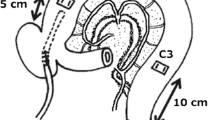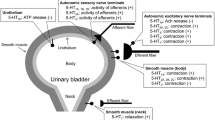Abstract
We examined the effects of exogenous 5-hydroxytryptamine (5-HT) and selective 5-HT receptor agonists and antagonists on proximal, middle and distal colonic motility in conscious fasted dogs with extraluminal force transducers implanted chronically. 5-HT (0.003–0.1 mg/kg i.v.) dose-dependently enhanced motility along the entire length of the colon. The 5-HT (0.03 mg/kg i.v.)-induced response was inhibited by 0.1–1.0 mg/kg i.v. methysergide, a 5-HT/12 antagonist, at all recording sites and by 0.1–1.0 mg/kg i.v. ketanserin, a 5-HT2A antagonist, at the middle and distal sites only. At 1 mg/kg i.v., YM060, a 5-HT3 antagonist, reduced the amplitude of the initial transient high-amplitude contractions induced by 5-HT, but did not affect the tonic contraction induced by 5-HT. At doses up to 3 mg/kg i.v.,2-methoxy-4-amino-5-chlorobenzoic acid 2-(diethylamino) ethyl ester (SDZ205-557), a 5-HT4 antagonist, and hexamethonium (up to 10 mg/kg i.v.) did not affect 5-HT-induced responses at any recording site. Renzapride, a 5-HT4 agonist, also stimulated motility along the entire length of the colon at 0.3 mg/kg i.v.. The renzapride-induced response was inhibited by 1 mg/kg i.v. SDZ205-557 or 3 mg/kg i.v. hexamethouium. m-Chlorophenylbiguanide (m-CPBG), a 5-HT3 agonist, (1 mg/kg i.v.) produced a transient high-amplitude contraction at all recording sites and this contraction was eliminated by pretreatment with 0.03 mg/kg i.v. YM060. The contraction produced by m-CPBG declined rapidly, so the increase in the motility index by m-CPBG was not significant at any recording site. Of the antagonists tested, 0.1–1 mg/kg i.v. methysergide produced a delayed and prolonged contractile response at the middle and distal sites. The onset of the response was delayed about 20 min after application and the response was maintained over the subsequent 60-min observation period. The methysergide (1 mg/kg i.v.)-induced response was inhibited by 3 mg/kg i.v. hexamethonium. The other antagonists, ketanserin, YM060 and SDZ205-557, had no contractile effect at any recording site.
These results indicate that exogenous 5-HT stimulates motility along the entire length of the fasted canine colon and that 5-HT-induced responses in the proximal colon are mediated mainly by 5-HT1, whereas those in the middle and distal colon are mediated by both 5-HT1 and 5-HT2 receptors. Renzapride and methysergide also stimulate colonic motility via additional mechanisms. The activation of 5-HT4 receptors and the blockade of endogenous 5-HT inhibitory regulation via 5-HT1 receptors may be involved in the action of renzapride and methysergide respectively.
Similar content being viewed by others
References
Baumgarten HG (1982) Morphological basis of gastrointestinal motility: structure and innervation of gastrointestinal tract. In: Bertaccini I (ed) Mediators and drugs in gastrointestinal motility. Springer Berlin, Heidelberg, New York, pp 7–45
Boeckxstaens GE, Pelckmans PA, Rampart M, Bogers JJ, Verbeuren TJ, Herman AG, Maercke YM van (1990) Pharmacological characterization of 5-hydroxytryptamine receptors in the canine terminal ileum and ileocolonic junction. J Pharmacol Exp Ther 254:652–658
Buchheit KH, Buhl T (1991) Prokinetic benzamides stimulate peristaltic activity in the isolated guinea pig ileum by activation of 5-HT4 receptors. Eur J Pharmacol 205:203–208
Buchheit KH, Gamse R, Pfannkuche HJ (1991) SDZ205–557, a selective antagonist at 5-HT4 receptors in the isolated guinea pig ileum. Eur J Pharmacol 200:373–374
Bueno L, Fioramonti J (1982) A possible central serotonergic mechanism involved in the effects of morphine on colonic motility in dog. Eur J Pharmacol 82:147–153
Craig DA, Clarke DE (1991) Peristalsis evoked by 5-HT and renzapride: evidence for putative 5-HT4 receptor activation. Br J Pharmacol 102:563–564
Davidson HI, Pilot MA, Thompson HH (1990) Involvement of 5-hydroxytryptamine in canine intestinal motility patterns. J Gastrointest Mot 2:31–39
Derkach V, Surprenant A, North RA (1989) 5-HT3 receptors are membrane ion channels. Nature 339:706–709
Dumuis A, Bouhelal R, Sebben M, Cory R, Bockaert J (1988) A nonclassical 5-hydroxytryptamine receptor positively coupled with adenylate cyclase in the central nervous system. Mol Pharmacol 34:880–887
Dumuis A, Sebben M, Bockaert J (1989a) BRL24924: a potent agonist at a non-classical 5-HT receptor positively coupled with adenylate cyclase in colliculi neurons. Eur J Pharmacol 162:381–384
Dumuis A, Sebben M, Bockaert J (1989b) The gastrointestinal prokinetic benzamide derivatives are agonists at the non-classical 5-HT receptor (5-HT4) positively coupled to adenylate cyelase in neurons. Naunyn-Schmiedeberg's Arch Pharmacol 340:403–410
Elswood CJ, Bunce KT, Humphrey PPA (1991) Identification of putative 5-HT4 receptors in guinea-pig ascending colon. Eur J Pharmacol 196:149–155
Engel G, Hoyer D, Kalkman HO, Wick MB (1984) Identification of 5-HT2-receptors on longitudinal muscle of the guinea pig ileum. J Receptor Res 4:113–126
Fishlock DJ, Parks AG (1963) A study of human colonic muscle in vitro. B MJ 2:666–667
Gullikson GW, Virina MA, Loeffler RE, Yang DC, Goldstin B, Wang SX, Moummi C, Flynn DL, Zabrowski DL (1993) SC-49518 enhances gastric emptying of solid and liquid meals and stimulates gastrointestinal motility in dogs by a 5-hydroxytryptamine4 receptor mechanism. J Pharmacol Exp Ther 264:240–248
Hata F, Kataoka T, Takeushi T, Yagosaki O, Yamano N (1990) Differences in control of descending inhibition in the proximal and distal regions of rat colon. Br J Pharmacol 101:1011–1015
Hoyer D, Clarke DE, Fozard JR, Hartig PR, Martin GR, Mylecharane EJ, Saxena PR, Humphrey PPA (1994) International Union of Pharmacology classification of receptors for 5-hydroxytryptamine (serotonin). Pharmacol Rev 46:157–202
Itoh Z, Honda R, Takeushi S, Aizawa I, Takayanagi R (1977) An extraluminal force transducer for recording contractile activity of the gastrointestinal smooth muscle in conscious dogs: Its construction and implantation. Gastroenterol Jpn 12:275–283
Itoh Z, Mizumoto A, Iwanaga Y, Yoshida N, Torii K, Wakabayashi K (1991) Involvement of 5-hydroxytryptamine 3 receptors in regulation of interdigestive gastric contractions by motilin in the dog. Gastroenterology 100:901–908
Kadowaki M, Nagakura Y, Tokoro K, Tomoi M, Mori J, Kohsaka M, Kuwahara A (1992) Effect of FK1052, a potent 5-HT3 and 5-HT4 receptor antagonist, on gastrointestinal function. Gastroenterology 102:A739
Kamato T, Ito H, Nagakura Y, Yamano M, Miyata K (1992) Serotonin (5-HT)3-receptor-mediated colonic contraction in conscious rats (abstract). Jpn J Pharmacol 58(Suppl I):128p
Kilpatrick GJ, Butler A, Burridge J, Oxford AW (1990) 1-(m-Chlorophenyl)-biguanide, a potent high affinity 5-HT3 receptor agonist. Eur J Pharmacol 182:193–197
Mawe GM, Branchek TA, Gershon MD (1986) Peripheral neural serotonin receptors: identification and characterization with specific antagonists and agonists. Proc Natl Acad Sci USA 83:9799–9803
McCallum RW, Prakash C, Campoli-Richards DM, Goa KL (1988). Cisapride. A preliminary review of its pharmacodynamic and pharmacokinetic properties, and therapeutic use as a prokinetic agent in gastrointestinal motility disorders. Drugs 36:652–681
Mine Y, Yoshida N, Yoshikawa T, Ito T (1995) Comparison of effect of mosapride citrate and other substituted benzamides on gastrointestinal motility (abstract). Jpn J Pharmacol 67(Suppl I): 199p
Misiewicz JJ, Waller SL, Eisner M (1966) Motor responses of human gastrointestinal tract to 5-hydroxytryptamine in vivo and in vitro. Gut 7:208–216
Miyata K, Kamato T, Nishida A, Ito H, Katsuyama Y, Iwai A, Yuki H, Yamano M, Tsutsumi R, Ohta M, Takeda M, Honda K (1991) Pharmacological profile of (R)-5-[(methyl-3-indolyl)carbonyl]-4,5,6,7-tetrahydro-1H-benzimidazol hydrochloride (YM060), a potent and selective 5-hydroxytryptamine3 receptor antagonist, and its enantiomer in the isolated tissue. J Pharmacol Exp Ther 259:15–21
Nagakura Y, Miyata K, Kamato T, Nishida A, Ito H, Yamano M, Usuda S (1995) The modulation of gastric antral motility by 5-hydroxytryptamine (5-HT)3 receptors in dogs (abstract). Gastroenterology 108:A655
Ng WW, Jing J, Hyman PE, Snape WJ Jr (1991) Effect of 5-hydroxytryptamine and its antagonists on colonic smooth muscle of the rabbit. Dig Dis Sci 36:168–173
Ormsbee HS, Silber DA, Hardy FE Jr (1984) Serotonin regulation of the canine migrating motor complex. J Pharmacol Exp Ther 231:436–440
Sarna SK, Condon RE, Cowles V (1984) Colonic migrating and non-migrating motor complexes in dogs. Am J Physiol 246: G355-G360
Saxena PR, Villalon CM (1990) Cardiovascular effects of serotonin agonists and antagonists. J Cardiovasc Pharmacol 15:S17-S34
Sepulveda ML, Lummis SCR, Martin IL (1991) The agonist properties of m-chlorophenylbiguanide and 2-methyl-5-hydroxytryptamine on 5-HT3 receptors in NIE-115 neuroblastoma cells. Br J Pharmacol 104:536–540
Talley NJ (1992) 5-hydroxytryptamine agonists and antagonists in the modulation of gastrointestinal motility and sensation: clinical implications. Aliment Pharmacol Ther 6:273–289
Tonini M, Rizzi CA, Manzo L, Onori L (1991) Novel enteric 5-HT4 receptors and gastrointestinal prokinetic action. Pharmacol Res 24:5–14
Woollard DJ, Bornstein JC, Furness JB (1994) Characterization of 5-HT receptors mediating contraction and relaxation of the longitudinal muscle of guinea-pig distal colon in vitro. Naunyn-Schmiedeberg's Arch Pharmacol 349:455–462
Yamazaki S, Yano T, Ogawa S, Tobe A (1995) Effects of MKC-733, a new prokinetic compound, on gastrointestinal motility in rats and dogs (abstract). Jpn J Pharmacol 67(Suppl I): 189p
Yoshida N, Mizumoto A, Iwanaga Y, Itoh Z (1991) Effects of 5-hydroxytryptamine 3 receptor antagonists on gastrointestinal motor activity in conscious dogs. J Pharmacol Exp Ther 256:272–278
Author information
Authors and Affiliations
Rights and permissions
About this article
Cite this article
Nagakura, Y., Kamato, T., Nishida, A. et al. Characterization of 5-hydroxytryptamine (5-HT) receptor subtypes influencing colonic motility in conscious dogs. Naunyn-Schmiedeberg's Arch Pharmacol 353, 489–498 (1996). https://doi.org/10.1007/BF00169167
Received:
Accepted:
Issue Date:
DOI: https://doi.org/10.1007/BF00169167




